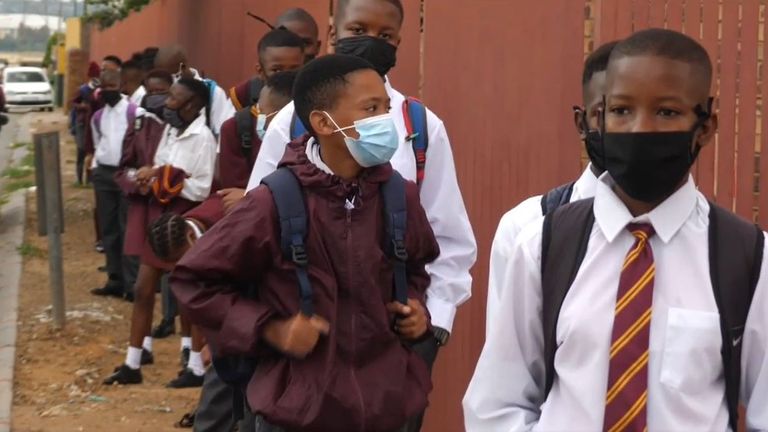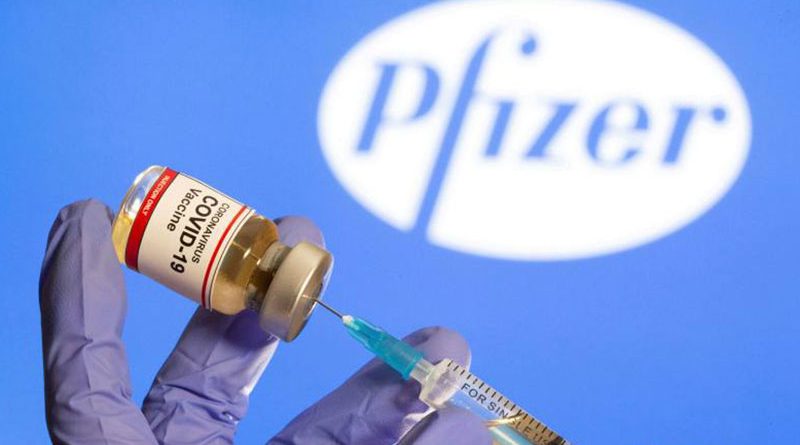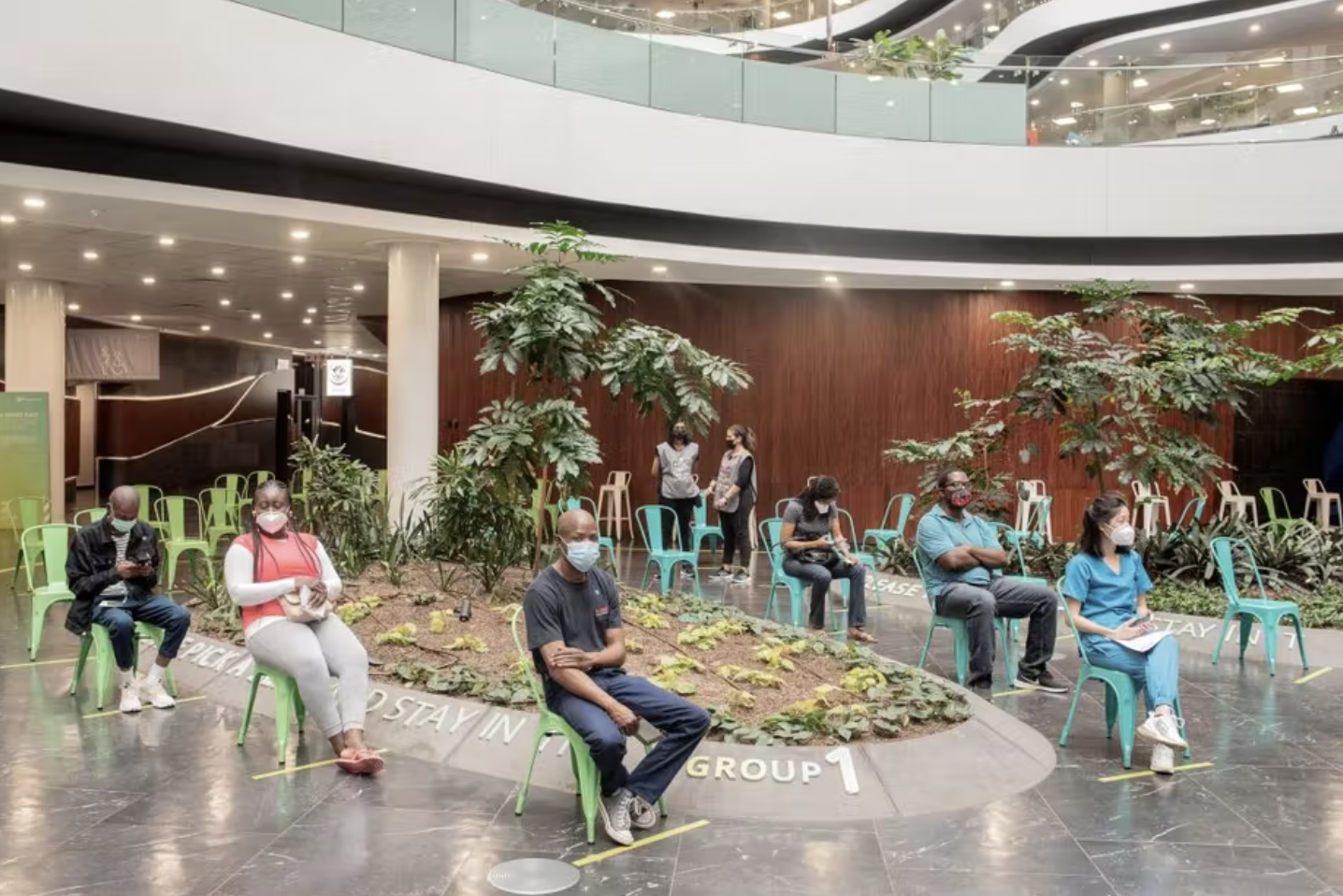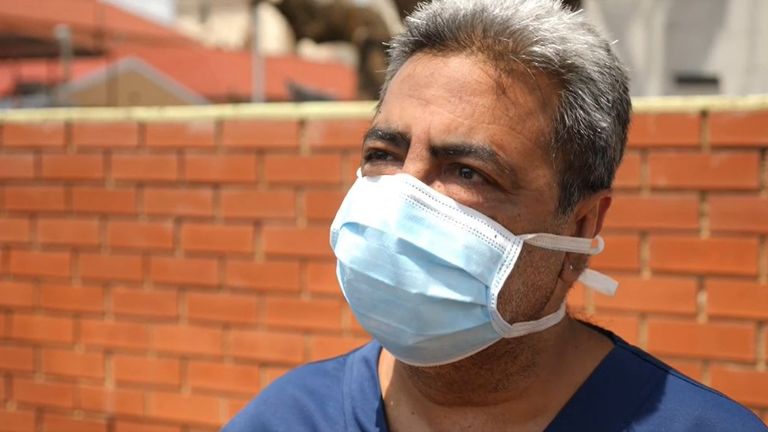South Africa has changed its Covid-19 vaccination rules in an effort to encourage more people to get jabs, health authorities said on Monday.
Inoculations have slowed and the country — which has recorded more than 98,000 deaths and more than 3.6 million positive Covid-19 cases in total in the pandemic — has ample vaccine stocks.
The government is shortening the interval between the first and second doses of the Pfizer vaccine from 42 to 21 days and will allow people who have received two doses of Pfizer to get a booster dose three months after their second shot as opposed to six months previously.
It will also offer the option of “mixing and matching” booster jabs, with adults who were given one dose of Johnson & Johnson’s (J&J) vaccine being offered either a J&J or Pfizer booster two months after their J&J shot. Adults who received two doses of Pfizer will be allowed J&J as well as Pfizer as a third dose.
“The decision regarding which vaccine to administer as a booster should be guided by vaccine availability,” the health department said in a statement.
South Africa has recorded the most coronavirus infections and deaths on the African continent.
It has so far fully vaccinated 28 per cent of its roughly 60 million population, or 42 per cent of its 40 million adults. That is a far greater percentage than many other African countries but well short of government targets.
Its vaccination campaign, using the J&J and Pfizer vaccines, got off to a slow start due to difficulties securing early supplies but more recently it has been dogged by hesitancy.
Also on Monday, a government adviser on Covid-19 treatments shed further light on a recommendation that the state should not buy Merck & Co’s pill molnupiravir for now, despite the health regulator authorising its use.
Jeremy Nel, head of the infectious diseases division at the University of the Witwatersrand, told Reuters that the National Essential Medicines List Committee had given molnupiravir a “conditional no” on the basis that the cost would be substantial and benefits relatively small.
“It’s not a magic bullet that is going to solve Covid,” Nel said of molnupiravir.
Pfizer’s treatment pill Paxlovid was going to become available and had shown greater efficacy, Nel said. The committee is reviewing evidence on Paxlovid and should come up with a recommendation for government within weeks.
South Africa’s decision to steer away from buying molnupiravir comes after France cancelled its order following disappointing trial data. France hopes to get Paxlovid instead.
Source - Khaleej Times
GABORONE, BOTSWANA —
Botswana will allow unvaccinated travelers into the country, provided they produce a negative COVID-19 test result. That’s a reversal from last month, when the nation started denying entry to travelers who were partially vaccinated or unvaccinated and not willing to get a free shot.
Botswana Ministry of Health spokesperson Christopher Nyanga said in a statement the decision to allow the unvaccinated into the country was meant to ensure smooth entry for travelers.
“I wish to indicate that these changes now allow partially vaccinated or unvaccinated people to enter the country, if they comply with the required testing requirements,” he said. “It is only when one is not fully vaccinated and is also not willing to undergo COVID-19 testing at the port of entry, that they will be charged and fined or taken to a court of law.”
There was confusion over what determined a fully vaccinated person. In Botswana, the vaccine validity period is 180 days, while Europe gives the same vaccines a 270-day validity period.
Nyanga says the vaccine validity discord was taken into consideration when dropping the vaccine mandate.
“Due to discordant periods for taking booster shots between Botswana and other countries, and for purposes of smoothening international travel, the definition of being fully vaccinated in Botswana will no longer include a booster shot,” he said. “Having completed the primary vaccine series will be considered sufficient for one to be allowed entry, without the need to present a negative PCR test result.”
Cindy Kelemi , director of the human rights organization Botswana Network on Ethics, Law and HIV-AIDS, welcomed the government’s move.
“We have always maintained that the response to COVID-19 does not necessarily require for criminalization to be used as a strategy,” she said. “And not allowing entry to those who are not vaccinated is actually a violation of people’s rights. Therefore, it was only reasonable for the government to retract its previous guidelines and remove the barring of people who are not vaccinated, into Botswana."
Since the introduction of vaccine mandates on Feb. 14, Botswana’s tourism industry says, it has suffered huge losses, with canceled bookings worth $10 million.
A tour guide in the Okavango Delta, Keletso Sedume, said he expects the situation to improve now that COVID-19 entry requirements have been eased.
"It is good news as there was a drop of tourists coming to the delta in the last few weeks,” he said. “We heard it is because some were reluctant to vaccinate and had canceled their bookings. We hope to see them come in now."
Botswana authorities say they have vaccinated more than 71% of the adult population, which is one of the highest vaccination rates on the continent.
Source - VOA
A recently published South African study set out to determine sero-positivity against SARS-CoV-2 before the fourth wave of COVID-19, in which the omicron variant was dominant. Sero-positivity measures the presence of antibodies against the virus; it indicates past infection. The study focused on Gauteng, the country’s economic hub. Ozayr Patel asked Shabir Madhi to unpack the results and explain why the findings suggest that South Africa has reached a turning point in the pandemic.
What we found
The results show the levels of sero-positivity – in other words what percentage of people have antibodies to the virus – among just over 7,000 people from whom samples were taken. From these results the following rates were calculated:
-
In those under 12 years of age, none of who received a COVID-19 vaccine, 56% showed presence of antibodies to SARS-CoV-2
-
In those over 50 it was 80%, including 70% if unvaccinated and 93% if vaccinated
-
In high density inner city areas the sero-positivity prevalence was 85%
Using the seroprevalence data, together with COVID-19 attributable deaths using excess mortality data from the South African Medical Research Council, the study was also able to impute the risk of dying following infection by SARS-CoV-2 prior to the Omicron wave in South Africa. This infection fatality risk for COVID-19 was 0.57% pre-omicron in Gauteng. This is substantially higher than 0.019% imputed for seasonal flu, which infected one-third of the population each year pre-COVID, calculated using similar methods.
Vaccination coverage: We discovered high levels of hybrid immunity: that is immunity gained from a combination of previous infections plus vaccinations.
At the time of the onset of the omicron wave, 36% of people in Gauteng had at least one dose of the vaccine. This was higher – 61% – in those over the age of 50. (This cohort was responsible for more than 80% of deaths pre-omicron.)
Based on sero-survey, 70% of vaccinated people were also infected pre-omicron. Hence they would have had substantial hybrid immunity, which has been shown to induce a broader repertoire of immune responses against the virus. Such hybrid immunity in South Africa has, however, come at the cost of loss of 300,000 lives based on South African Medical Research Council excess mortality estimates. These are three-fold higher than the official recorded number of deaths.
Based on another study, the hybrid immunity is expected to confer greater protection against infection and mild COVID-19 compared with immunity only from vaccine or natural infection.
Hospitalisations and death rates: Our study also analysed the temporal trends in COVID-19 cases, hospitalisations and deaths (recorded and COVID attributable from excess mortality) from the start of the pandemic up until the tail end of the Omicron wave. The study found a massive decoupling between the number of people becoming infected with the virus relative to COVID hospitalisation and death rates during the course of omicron compared with earlier waves. This was true across all adult age groups.
The omicron wave was associated with 10% of all hospitalisations since the start of the pandemic, whereas 44% of hospitalisations had transpired during the course of the Delta variant wave. More impressively, only 3% of COVID deaths since the start of the pandemic occurred during the omicron wave, compared with 50% during the delta dominant wave.
The findings of decoupling of infections and severe or fatal COVID-19 were similar in the 50-59 year age group. In this group the omicron wave contributed to 15% of recorded COVID hospitalisations and 2% of deaths since the start of pandemic. This compares with 46% of hospitalisations and 53% of deaths occurring in the third wave, dominated by delta. The data for people over 60 years old was similar.
The survey also found that 58% of children under 12 years of age (all unvaccinated) were sero-positive. They were not more heavily affected during the Omicron wave.
The delta dominant wave which was the most severe in South Africa, coincided with South Africa’s belated COVID vaccine rollout. The high death rate during that wave is an indictment of the missed opportunities that could have prevented a large percentage of the deaths which transpired. In particular, the delayed procurement and roll out of COVID-19 vaccines in South Africa, as well as the ill-informed decision to against the WHO recommendation on the continued use of the AstraZeneca vaccine which was available to in South Africa when the Beta variant was circulating in South Africa.
In summary, the omicron wave contributed to less than 5% of all COVID-19 deaths in Gauteng. Since the start of the pandemic, the delta variant wave contributed to 50% of all of the deaths. The balance is split roughly equally between the first and second waves caused by ancestry and the beta variant.
Our findings also show that natural infection has been high and is playing a major role in how the pandemic has unfolded especially in countries with low to moderate COVID-19 rollout. These high levels of infections have, however, resulted in a massive loss of lives; which to date is likely under-estimated in low and middle income countries as shown from the South African data.
What the findings tell us
The findings indicate that South Africa is moving into the convalescent phase of the COVID pandemic – the recovery phase. This is likely to be the same in other countries with low or modest vaccine uptake, but high force of past infections. As such, South Africa needs to recaliberate its approach to the pandemic and to start managing it as we would do for other respiratory infections which too cause large number of hospitalisations and deaths.
There are still a few unknowns. Another resurgence is likely, and there might well be another variant. But it would be very surprising if further variants are able to evade the T-cell arm of the immune system which is stimulated by vaccines and natural infection. The T-cell (cell mediated immunity) arm of the immune system, appears to be the main mediator of protecting against severe COVID-19, even when there are breakthrough infections in vaccinated people or reinfections.
So why do I believe that we are at the tail end of this pandemic? It depends what metric you use. If it’s about infections, we’re not at the tail end. If it’s about the number of deaths that will transpire from COVID-19 during 2022, relative to the number of deaths that will transpire from other preventable causes of death in countries such as South Africa, then I believe the country has pretty much arrived towards the end of this pandemic.
In South Africa about 10,000 to 11,000 people die of seasonal influenza every year. In 2019 tuberculosis killed 58 000 in 2019. But we are not declaring an emergency in South Africa to deal with flu or tuberculosis. Deaths from HIV, and complications from HIV, are about 70,000. But South Africa isn’t shutting down the country to prevent deaths and infections from these diseases.
Now what?
Only 12% of people across the continent have received one dose of vaccination. The implications of our findings are that:
- Vaccine coverage must be enhanced by ensuring that adequate booster doses are given to those who require it. We might need to continue boosting. This might need to be on an annual basis for the next two to three years, especially for high risk individuals. The time line for this is until we have more experience on the durability of protection of vaccines, particularly in settings with a high prevalence of hybrid immunity (where protection may be even longer lasting. )
Campaigns should be focused primarily on high risk groups, including getting over 90% of people over 50 years of age vaccinated before the next resurgence anticipated. This should be the focus rather than the current arbitrary target of vaccinating 40%-70% of the population.
-
It’s still beneficial to expand vaccinations in settings with high sero-positivity. Studies on hybrid immunity show this delivers more robust and broader repertoire immune responses that could heighten protection against infection, and reduce the magnitude of future resurgences.
-
It’s also important that key non-pharmacuetical interventions are kept in place. This includes wearing masks in crowded poorly ventilated indoor places, and particularly high risk individuals when there is an increase in virus transmission activity.
Our findings support the optimism expressed at the beginning of 2022 in South Africa that a turning point had been reached in the pandemic. Many in high income countries dismissed this view as not applicable to their settings despite high vaccine coverage. But their experience has since generally aligned with South Africa’s.
Read more: South Africa has changed tack on tackling COVID: why it makes sense
Lastly, better COVID vaccines are required. But the world is no longer at “code red”. And it’s time to rebuild livelihoods, economies and all other facets of life that were affected over the past two years. This is particularly true in fragile low and middle income countries.
Source : The Conversation
When South Africa's hardy yet overworked health system shifted to address the COVID pandemic, the work of diagnosing people with HIV - and maintaining contact with those who already have the virus - was neglected.
As the Omicron variant continues to sweep the world, registering a record number of infections in Japan, Russia and Romania amongst others, the country where the strain was first documented is now preparing to bid it goodbye.
Omicron was first picked up by technicians in a laboratory in South Africa. A few weeks later, a handful of doctors at the main hospital in the country's capital, Pretoria, provided the first analysis of its behaviour after admitting dozens of new COVID patients.
It was at that point that Steve Biko Academic Hospital's Dr Fareed Abdullah told the world that Omicron was not like the variants which fuelled previous waves.
Live COVID updates from UK and around the world

Image:
The strain was highly infectious but it was significantly less likely to put people in hospital - or cost them their lives. Major studies in the UK and US on the severity of the disease have confirmed these initial observations made in South Africa.
"Are we closer to the end of this wave than the beginning?" I asked.
"The data is showing that we're right at the end of the wave, our case rates are almost where they were pre-wave level, we really have a view now of the whole wave and can describe it properly," said Dr Abdullah, as he stripped off his protective garments outside the hospital's ICU ward.
Yet there is another issue now concerning this clinician and the rest of the medical community in South Africa.
Seroprevalence surveys indicate that more than three-quarters of the population have already generated immunity from previous COVID-19 infections - one reason why Dr Abdullah and others think the fall-out from Omicron was relatively mild.
However, there is one group who are thought to be at particular risk - any of the millions of people in South Africa who suffer from weakened immune systems, like those with HIV.
HIV is a key public health concern in South Africa with an estimated eight million people (13% of the population) living with the disease. There is tried and tested medicine for this, called antiretrovirals. It keeps HIV at bay, thereby allowing the body's immune system to function normally. But patients need to take the medication consistently.
When South Africa's hardy yet overworked health system shifted to address the COVID pandemic, the work of diagnosing people with HIV - and maintaining contact with those who already have the virus - was neglected.
Public health organisations like Right to Care estimate that some 3.6 million have either gone undiagnosed or are not currently on a consistent antiretroviral regime.
"In South Africa, we want to make sure that more and more people with HIV get into treatment so they don't fall into that category, but in my humble opinion, that is where the epidemic is shifting now," says Dr Abdullah.
Finding and reintegrating those carrying the HIV virus into the system is just one part of the challenge however.
New strains could evolve
Early on in the pandemic, scientists discovered that the immunocompromised tend to suffer from particularly long and severe COVID infections with prolonged periods of infectiousness.
In addition, work done by scientists in Durban has shown how COVID can mutate inside the bodies of those with untreated HIV. In one case, they traced a coronavirus sample to a 36-year-old HIV patient who was struggling to adhere to her antiretroviral treatment regime. Over the course of her seven-month COVID infection, the virus acquired 32 mutations.
The risk is clear. New variants of concern could evolve - and be transmitted - by those with weakened immune systems.
"It means a major reorganisation of the health service because these people are difficult to find. How do you make the diagnosis in these people? But that is where modern medicine has to take us, rapidly," says Dr Fareed Abdullah.
In a town called Klerksdorp in South Africa's North West Province, health workers are trying to re-establish contact with dozens of HIV patients who have fallen off the local health authority's radar.
'I was so sick'
A 40-year-old woman called Sylvia van Wyk stopped taking antiretroviral tablets two years ago - and when she picked up COVID, she couldn't get rid of it.
"I was so sick, I couldn't do nothing, nothing at all, my mum was there for me, she was washing me, feeding me, I couldn't do nothing for myself, nothing," she said.
Sylvia had COVID for three agonising months but when she re-started her HIV treatment, her body fought the virus off.
"Why did you stop taking (your antiretrovirals)?" I asked.
"Truly speaking, I was entertaining too much, I was entertaining, I wasn't taking care of my health," she said.
South African scientists warn that it is crucial that people like Sylvia continue to take their HIV treatments for fear of the development of some, "really nasty variants," in the words of one leading figure.
It will require a determined pivot from an already-exhausted health service but our collective health may depend on it.
Source : Sky News






